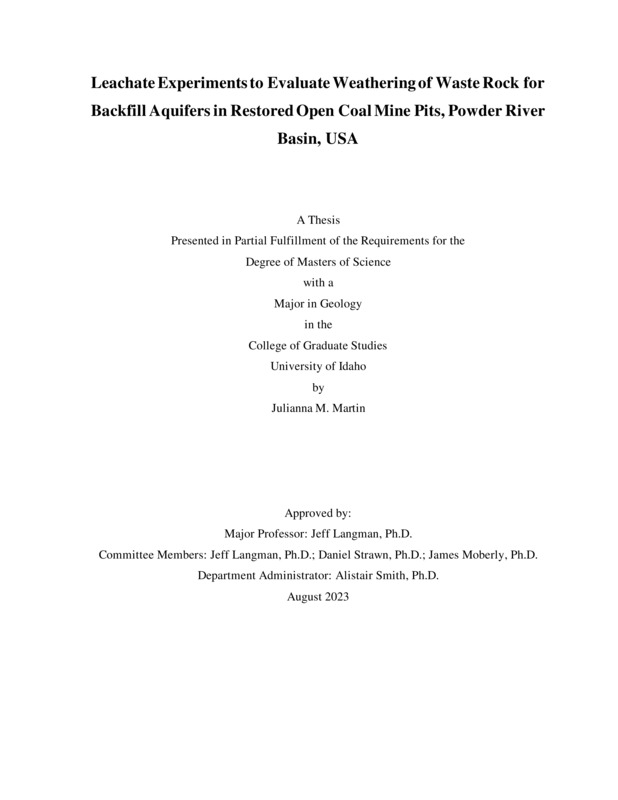Leachate Experiments to Evaluate Weathering of Waste Rock for Backfill Aquifers in Restored Open Coal Mine Pits, Powder River Basin, USA
Martin, Julianna Marie. (2023-08). Leachate Experiments to Evaluate Weathering of Waste Rock for Backfill Aquifers in Restored Open Coal Mine Pits, Powder River Basin, USA. Theses and Dissertations Collection, University of Idaho Library Digital Collections. https://www.lib.uidaho.edu/digital/etd/items/martin_idaho_0089n_12683.html
- Title:
- Leachate Experiments to Evaluate Weathering of Waste Rock for Backfill Aquifers in Restored Open Coal Mine Pits, Powder River Basin, USA
- Author:
- Martin, Julianna Marie
- ORCID:
- 0000-0003-4605-4146
- Date:
- 2023-08
- Keywords:
- Mine waste Water quality Weathering
- Program:
- Geography & Geological Science
- Subject Category:
- Geology
- Abstract:
-
Open-pit mining companies utilize waste rock for landscape restoration which may include the construction of backfill aquifers. Chemical weathering and contaminant transport can be altered in backfill aquifers because of the mining of the waste rock that produces newly available mineral surfaces and nanoparticles that can impact water quality. Waste rock from the Cordero Rojo open-pit coal mine in the Powder River Basin was exposed to benchtop weathering experiments for 20 weeks at temperatures of 5 °C and 20 °C. Leach columns containing 4 kg of waste rock were saturated and drained twice weekly. Collected leachate was analyzed for Eh, pH, alkalinity, specific conductance, and cation and anion concentrations as unfiltered and 0.45-μm and 0.2-μm filtered concentrations. During the experiment, leachate Eh and pH substantially varied during the first 50 days, which corresponds to a period of high specific conductance and alkalinity values. Correspondingly, anion and cation concentrations were the largest during this early weathering stage and the filter fractions indicated multiple weathering processes, such as particle transport, salt dissolution, and sulfide oxidation. After this early weathering stage, all environmental parameters slowly evolved towards a chemical equilibrium of neutral, oxidizing, and low solute conditions. This evolution was reflected in the decline and stabilization or non-detection of metal(loid) concentrations reflective of a shift to primarily bulk aluminosilicate weathering. Over the course of the experiment, the solute trend of certain elements indicated particular weathering processes— cadmium and nanoparticle transport, selenium and salt dissolution, and arsenic and the oxidation of pyrite. Elements that are found in multiple sources, such as iron, indicated multiple weathering processes that occurred in the early weathering stage and throughout the experiment. The mining of the overburden formations created newly available mineral surfaces and nanoparticles that could release elements into solution that were not expected to be present given historical aquifer water quality for the overburden formations.
- Description:
- masters, M.S., Geography & Geological Science -- University of Idaho - College of Graduate Studies, 2023-08
- Major Professor:
- Langman, Jeff
- Committee:
- Moberly, James; Strawn, Daniel; Smith, Alistair
- Defense Date:
- 2023-08
- Identifier:
- Martin_idaho_0089N_12683
- Type:
- Text
- Format Original:
- Format:
- application/pdf
- Rights:
- In Copyright - Educational Use Permitted. For more information, please contact University of Idaho Library Special Collections and Archives Department at libspec@uidaho.edu.
- Standardized Rights:
- http://rightsstatements.org/vocab/InC-EDU/1.0/

